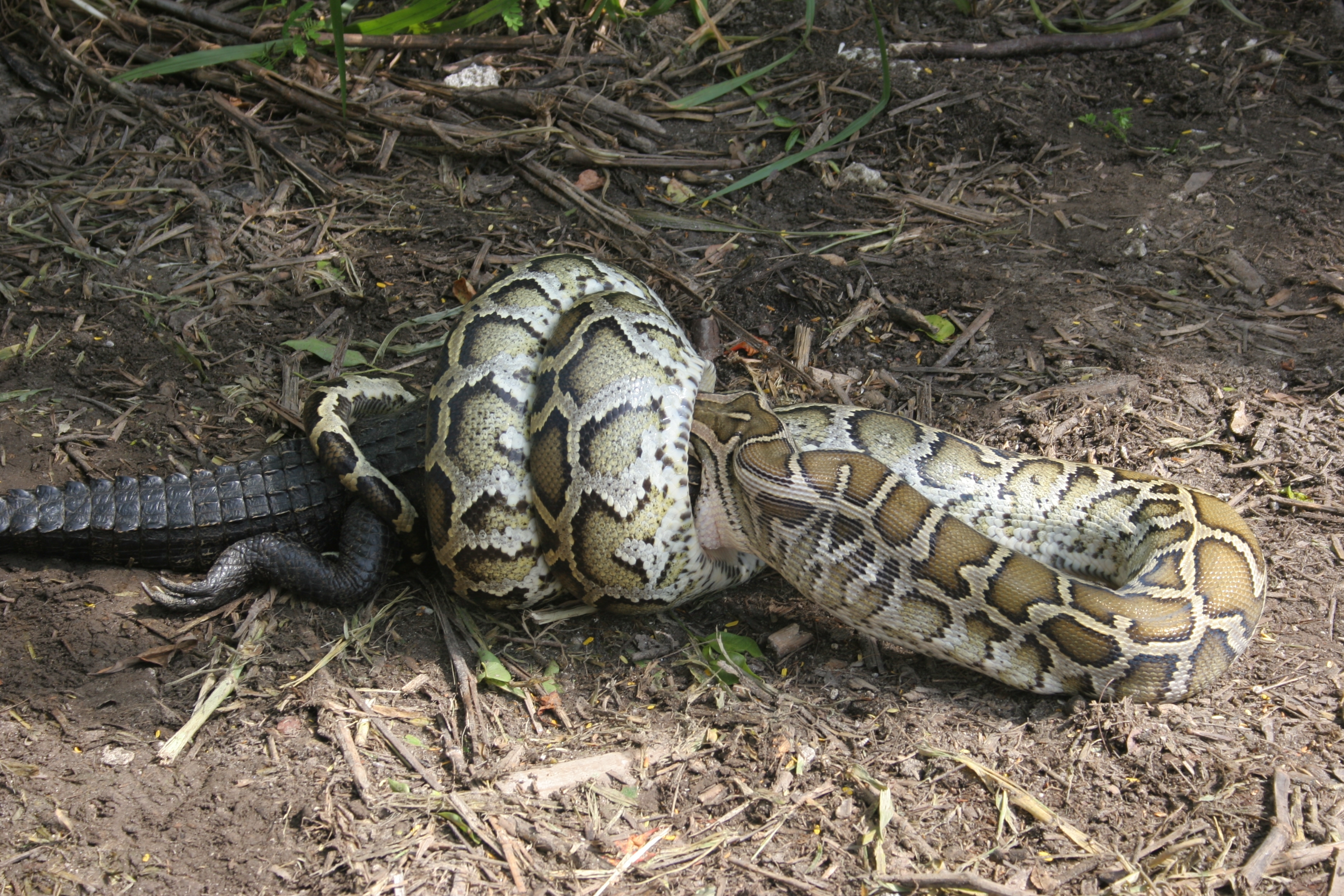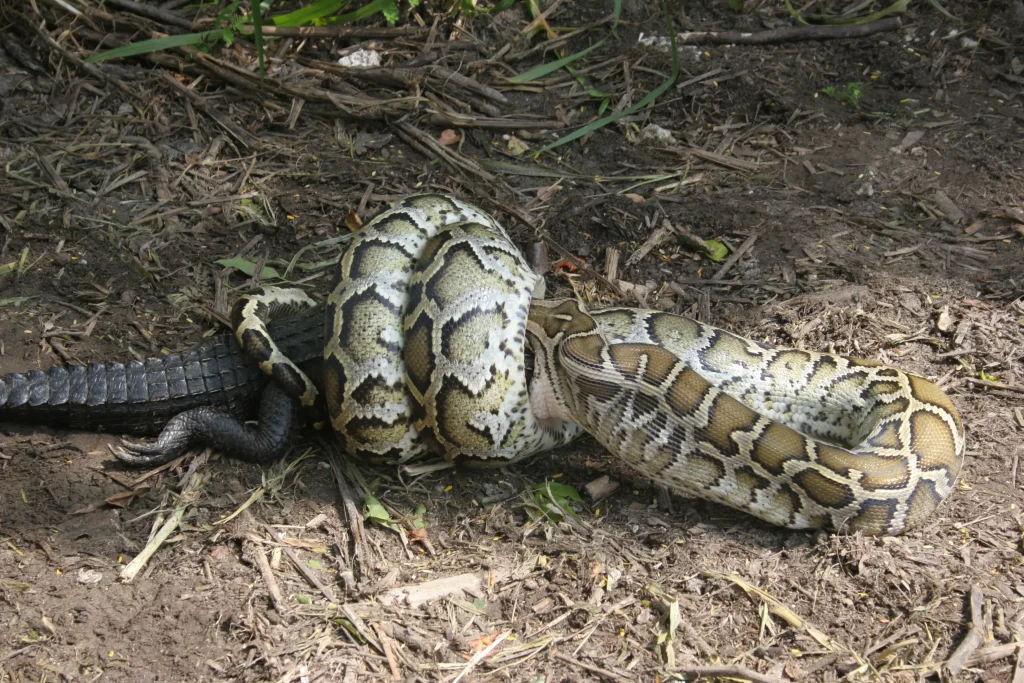Burmese pythons are an invasive species that have become a major problem in Florida’s Everglades. These massive snakes, which can grow up to 20 feet long and weigh over 200 pounds, are wreaking havoc on the ecosystem and posing a threat to native species.
The Burmese python population in Florida has exploded in recent years, thanks in part to pet owners who released their snakes into the wild when they grew too big to handle. Now, these snakes are decimating populations of small mammals and birds, throwing the delicate balance of the ecosystem out of whack. But what can be done to stop them?

Why Are Burmese Pythons a Problem?
Burmese pythons are large, non-venomous snakes that are native to Southeast Asia. However, since the 1980s, they have become an invasive species in the Florida Everglades and have caused significant ecological and economic damage. In this article, we will discuss the reasons why Burmese pythons are a problem and what measures are being taken to address the issue.
1. Rapid Population Growth
Burmese pythons are known for their rapid population growth. Female pythons can lay up to 100 eggs at a time, and their offspring can grow up to 20 feet long and weigh over 200 pounds. This fast growth rate has allowed the python population in the Everglades to explode in just a few decades.
To make matters worse, Burmese pythons have no natural predators in the Everglades. They are at the top of the food chain and can consume almost any animal they come across. This has led to a decline in the population of native species, including birds, deer, and small mammals.
2. Threat to Native Species
As mentioned before, Burmese pythons have had a devastating impact on the native species of the Everglades. They have been known to consume endangered species such as the wood stork and the Key Largo wood rat. They also compete with native predators such as alligators and panthers for food.
In addition, Burmese pythons can spread diseases to native species. For example, they have been linked to the spread of a deadly virus that affects native snakes.
3. Economic Impact
Burmese pythons have also had an economic impact on the Everglades. The area is a popular tourist destination, and the decline of native species has affected the tourism industry. In addition, the removal of pythons has become a costly endeavor for the state of Florida. The state has spent millions of dollars on programs to remove the snakes from the Everglades.
4. Human Safety Concerns
Although Burmese pythons are not venomous, they can be dangerous to humans. Large pythons have been known to attack and even kill humans. In addition, the presence of pythons in residential areas can be a safety concern for pets and small children.
5. Difficulty in Containment
Burmese pythons are difficult to contain due to their size and habitat. They can easily disappear in the dense vegetation of the Everglades, making them hard to locate. In addition, they can swim long distances, making it easy for them to escape from capture.
6. Challenges in Removal
Removing Burmese pythons from the Everglades is a challenging task. The snakes are elusive and can be hard to find. In addition, they are strong and can resist capture attempts. The state of Florida has implemented several programs to remove pythons from the Everglades, but the task remains difficult.
7. Benefits of Burmese Pythons
While Burmese pythons are a problem in the Everglades, they do have some benefits. For example, their skin is used to make leather products, and their meat is considered a delicacy in some parts of the world. However, the negative impact of their presence in the Everglades outweighs any potential benefits.
8. Comparison with Other Invasive Species
Burmese pythons are not the only invasive species in the Everglades. Other species, such as the Brazilian pepper tree and the melaleuca tree, have also caused ecological damage. However, the Burmese python has had a more significant impact due to its rapid population growth and ability to consume almost any animal it comes across.
9. Measures Being Taken to Address the Issue
The state of Florida has implemented several measures to address the Burmese python problem. These include:
– Allowing licensed hunters to capture and remove pythons from the Everglades
– Offering cash rewards for capturing large pythons
– Implementing a python removal program
– Encouraging the public to report python sightings
Despite these efforts, the python population in the Everglades remains a problem.
10. Conclusion
In conclusion, Burmese pythons are a significant problem in the Florida Everglades. Their rapid population growth, threat to native species, economic impact, and safety concerns have made them a top priority for the state of Florida. Although measures are being taken to address the issue, the task remains challenging, and the impact of their presence in the Everglades will be felt for years to come.
Frequently Asked Questions
Why are Burmese Pythons a problem?
Burmese pythons are a problem because they are an invasive species in Florida. They were first introduced to the state as pets but quickly became a problem when they were released into the wild or escaped from captivity. These snakes have no natural predators in Florida, which has allowed their population to grow exponentially.
Burmese pythons are also a problem because they are a threat to native wildlife. They are known to eat a variety of animals, including birds, mammals, and reptiles. This has had a significant impact on the ecosystem in Florida, as native species are being displaced by the pythons. In addition, the pythons are known to carry diseases that could potentially be transmitted to other animals, including humans.
How did Burmese pythons become a problem in Florida?
Burmese pythons became a problem in Florida because they were introduced to the state as pets. These snakes can grow to be quite large, which can make them difficult to care for. As a result, many people who purchased them as pets eventually released them into the wild or allowed them to escape from captivity.
Once in the wild, Burmese pythons were able to thrive in the warm, humid climate of Florida. With no natural predators, their population grew rapidly. Over time, they began to pose a threat to native wildlife, which led to increased concern about their presence in the state.
What is being done to control the Burmese python population in Florida?
There are several efforts underway to control the Burmese python population in Florida. One of the most effective methods is to capture and remove the snakes from the wild. A number of organizations have been established to help with this effort, and there are also programs in place to encourage the public to report sightings of Burmese pythons.
In addition to removal efforts, there are also efforts to prevent the spread of Burmese pythons in Florida. This includes prohibiting the possession of these snakes as pets and regulating the importation of exotic species. There are also ongoing research efforts to better understand the behavior of Burmese pythons and to develop more effective control methods.
Are Burmese pythons a threat to humans?
While Burmese pythons are not typically a threat to humans, they can be dangerous if provoked or cornered. These snakes are known to be aggressive when they feel threatened, and their bite can be painful and potentially dangerous. In addition, there have been reports of Burmese pythons attacking small pets and livestock.
It is also worth noting that Burmese pythons can carry diseases that could be transmitted to humans. While the risk of transmission is relatively low, it is still important to exercise caution when encountering these snakes in the wild.
What can individuals do to help control the Burmese python population in Florida?
There are several things that individuals can do to help control the Burmese python population in Florida. One of the most important is to report sightings of these snakes to the appropriate authorities. This can help experts to better understand the distribution and behavior of the snakes, which can inform control efforts.
Individuals can also help by following regulations related to the possession and importation of exotic species. By avoiding the purchase of exotic pets and supporting efforts to regulate the trade in these animals, individuals can help prevent the introduction of new invasive species.
Finally, individuals can support organizations that are working to remove Burmese pythons from the wild. This can include volunteering time or making financial contributions to support these efforts.
Burmese Python in Florida is Dangerous because..
In conclusion, Burmese pythons are a significant problem in many areas due to their invasive nature and ability to quickly reproduce. These giant snakes are not native to the regions they have invaded and have caused significant damage to the ecosystem. Their diet consists of native species, including mammals, birds, and reptiles, which has caused a decline in the population of these species.
The introduction of these snakes has also had a significant impact on the economy of the affected regions. The tourism industry has been negatively affected due to the threat of these snakes, and the cost of controlling their population has been significant. The Burmese python is a problem that must be dealt with to prevent further damage to the ecosystem and economy of these regions.
In conclusion, it is crucial to address the Burmese python problem to protect the environment, economy, and native species of the affected regions. The introduction of these snakes has caused significant damage, and their population must be controlled to prevent further harm. It is essential to raise awareness of this issue and take necessary actions to prevent the further spread of Burmese pythons.


